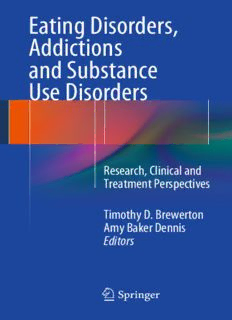
Eating Disorders, Addictions and Substance Use Disorders: Research, Clinical and Treatment Perspectives PDF
Preview Eating Disorders, Addictions and Substance Use Disorders: Research, Clinical and Treatment Perspectives
Eating Disorders, Addictions and Substance Use Disorders Research, Clinical and Treatment Perspectives Timothy D. Brewerton Amy Baker Dennis Editors 123 Eating Disorders, Addictions and Substance Use Disorders ThiSisaFMBlankPage Timothy D. Brewerton (cid:129) Amy Baker Dennis Editors Eating Disorders, Addictions and Substance Use Disorders Research, Clinical and Treatment Perspectives Editors TimothyD.Brewerton AmyBakerDennis PsychiatryandBehavioralSciences PsychiatryandBehavioralNeurosciences MedicalUniversityofSouthCarolina UniversityofSouthFlorida Charleston,SC,USA BloomfieldHills,MI,USA ISBN978-3-642-45377-9 ISBN978-3-642-45378-6(eBook) DOI10.1007/978-3-642-45378-6 SpringerHeidelbergNewYorkDordrechtLondon LibraryofCongressControlNumber:2014934149 #Springer-VerlagBerlinHeidelberg2014 Thisworkissubjecttocopyright.AllrightsarereservedbythePublisher,whetherthewholeorpart of the material is concerned, specifically the rights of translation, reprinting, reuse of illustrations, recitation,broadcasting,reproductiononmicrofilmsorinanyotherphysicalway,andtransmissionor informationstorageandretrieval,electronicadaptation,computersoftware,orbysimilarordissimilar methodologynowknownorhereafterdeveloped.Exemptedfromthislegalreservationarebriefexcerpts inconnectionwithreviewsorscholarlyanalysisormaterialsuppliedspecificallyforthepurposeofbeing enteredandexecutedonacomputersystem,forexclusiveusebythepurchaserofthework.Duplication ofthispublicationorpartsthereofispermittedonlyundertheprovisionsoftheCopyrightLawofthe Publisher’s location, in its current version, and permission for use must always be obtained from Springer.PermissionsforusemaybeobtainedthroughRightsLinkattheCopyrightClearanceCenter. ViolationsareliabletoprosecutionundertherespectiveCopyrightLaw. The use of general descriptive names, registered names, trademarks, service marks, etc. in this publicationdoesnotimply,evenintheabsenceofaspecificstatement,thatsuchnamesareexempt fromtherelevantprotectivelawsandregulationsandthereforefreeforgeneraluse. While the advice and information in this book are believed to be true and accurate at the date of publication,neithertheauthorsnortheeditorsnorthepublishercanacceptanylegalresponsibilityfor anyerrorsoromissionsthatmaybemade.Thepublishermakesnowarranty,expressorimplied,with respecttothematerialcontainedherein. Printedonacid-freepaper SpringerispartofSpringerScience+BusinessMedia(www.springer.com) To all the great teachers in my life, especially my patients, who taught me how to listen and to follow their lead, and to Therese, for whom I am infinitely grateful in so many ways T.D.B. To Daniel and our children, Jessica, Nicole, Michelle, and Christopher A.B.D. ThiSisaFMBlankPage Foreword We spend so much time studying in our specific area, evaluating and treating patients in our specialty, that we sometime lose sight of the forest for the trees. Whileweseesmokingpatients,whostoponlytogain20poundsoverthenextyear, or alcoholics and addicts who become ravenous upon successful abstinence, we somehow rarely think about the overlaps and relationship between substance use disorders and eating disorders. How often do we hear about a patient who has sought treatment multiple times at a substance use residential treatment program, neveraddressinghisorhereatingdisorder,onlytorelapseoverandoveragainuntil finallyfindingtreatmentthataddressesboththeeatingandsubstanceusedisorders (and vice versa)? It shouldn’t be surprising that cross-sectional studies of women with eating disorders have a higher prevalence of alcohol and substance abuse compared to the general female population as well; women with substance abuse disordersreportahigherprevalenceofeating-disorderedbehaviormoreoftenthan inthegeneralfemalepopulation.EatingDisorders,AddictionsandSubstanceUse Disorders:Research,Clinical,andTreatmentPerspectivesisamanualthatislong overdue and one that will help guide future research and treatment of patients in bothofthesefields. The intended audience of this book is researchers and clinicians who work in either field (substance use disorders or eating disorders). It is likely that if a clinicianworksineitherofthesefields,heorshe,inasense,worksinbothfields, whether the clinician is aware or not. We can only begin to imagine how often a patientwithadualdiagnosisofsubstanceuseandeatingdisorderpresentsseeking treatment in either setting, yet only one problem is addressed or even recognized uponpresentation.Thisbookservesasaguidefornewcliniciansandareminderfor cliniciansalreadyawareoftheoverlapbetweenthesetwofields.Itisalsoatoolfor the eating disorder specialist who is perhaps less familiar with working with individuals with substance use disorders as well as a tool for the substance abuse specialistwhoislessfamiliarwitheatingdisorders. Inadditiontotheclinicalperspectivesofferedinthisbook,thebookalsooffers newresearchthatisemergingthatsuggeststhattheoverlapbetweenthesetwoareas isevenstrongerthaninitiallyexpected.Inparticular,thechapter,“Neuroimagingof Eating Disorders, Substance Use Disorders and Addictions: Overlapping and Unique Systems,” summarizes the most recent neuroimaging literature and compares the similarities between eating disorders and substance use disorders. vii viii Foreword While the neuroimaging literature on eating disorders is relatively limited com- paredwithsubstanceusedisorders,thechapterhighlightsthesimilaritiesbetween bulimia nervosa, binge eating disorder, and addiction while pointing out the dissimilaritiesbetweenanorexianervosaandthesedisorders.Itisfascinatinghow similarbulimianervosaandbingeeatingdisorderaretosubstanceusedisordersin multiple studies that looked at executive control, motivation and reward, learning and memory, emotion regulation, and interoceptive awareness. This parallels real life as the overlap between substance use disorders and eating disorders tends to occur primarily in individuals who have binge eating and purging behavior as opposed to individuals with anorexia nervosa with restrictive subtype (who do notengageinbingeeatingandpurgingbehaviors). The implications of the overlap between eating disorders and substance use disordersareprofoundastheycanpotentiallyguidefuturediagnosisandtreatment. Basedonthesimilaritiesbetweenthetwo,onemayponderwhethereatingdisorders are addictions and whether this has diagnostic and treatment implications. While certainlyeatingdisordersareuniquefromsubstanceusedisorders,thesimilarities arepowerfulenoughtosuggestthatmoreresearchisneededinthisarea.Whilewe have focused on the brain and brain systems common to drug abuse, food preferences, eating disorders, and food addictions, there is much more to this field than our observation of it. If it looks like a duck and quacks, it is a duck. ThiswonderfulbookconceivedandbroughttothispointbyTimBrewerton,M.D., andAmyBakerDennis,Ph.D.,andtakesthefieldandinterrelationshipstothenext, verylogicalandcompellinglevel.Thanks,forthiswonderfuladditiontoourfield. Gainesville,FL,USA AmeliaDavis MarkS.Gold Preface In the past several decades, there have been numerous books published on the scienceandtreatmentofeatingdisorders(ED)andhundredsofvolumeswrittenon the diagnosis, assessment, and treatment of substance use disorders (SUD)/ addictions. At least to our collective knowledge, this is the first textbook to completely focus on the co-occurrence of these disorders. This project was born out of our surprise and deep frustration with both the lack of evidence-based research and treatment protocols for this comorbid population and the lack of availabletreatmentprograms,atalllevelsofcare,thateffectivelyserveconsumers withbothEDandSUD.Withupto50%ofEDpatientsmeetingcriteriaforaSUD or addiction and 1/3 of SUD patients reporting eating pathology, it is remarkable howfewpeopleineitherfieldarefullytrainedtoaddressbothdisorders.Addition- ally, we were hoping to strengthen connections between two fields that rarely communicate. With these issues in mind, we felt the time was right to assemble leadingexpertsfromeachfieldandaskthemtoworktogethertoproducea“state- of-the-art”textbookthatcouldnotonlyeducatepractitionersinbothfieldsbutalso promotecross-trainingandfurthercollaborativeresearch. The 30 chapters of this volume are organized into three major parts. The first, “Research Perspectives,” explores the science of ED, SUD, and addictions. Our researchersweretaskedwiththeresponsibilityofreviewingandreportingonwhat is known about each disorder independently and to discuss the similarities and differencesbetweenthesedisorders accordingtotheirtopic.Inordertomakethis part relevant to treatment providers, each author was asked to identify how this researchcanguideandinformclinicalpracticewithduallydiagnosedpatients.The first two chapters of this part focus on how animal research has informed our understanding of biological and behavioral factors that contribute to the develop- ment of ED and SUD as well as the relationship between eating and drug use behaviors.Chapter3explorestheneurobiologicalmechanismsandneurotransmit- ter/braincircuit alterations thatmaybecommon toboth disorders. Theauthorsof Chapter 4 discuss the finding from neuroimaging studies that examine shared and distinct domains of functioning (i.e., executive control, reward and motivation, emotional reactivity, memory/learning, and interoceptive awareness) and outline opportunities for future research to further clarify the relationship between addictionsandeatingbehaviors.Chapter5reviewsthecurrentempiricalliterature ix
Description: